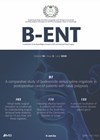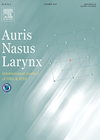
Journal Reviews
MRI scanning patients with cochlear implants and auditory brainstem implants
In the last five to six decades, MRI scanning has gone from physics experiments in Nottingham University through to Nobel prize-winning work by Sir Peter Mansfield and Paul Lauterbur, to a ‘routine’ imaging modality with an estimated 60 million MRI...
Management of postoperative cholesteatoma
This prospective longitudinal observational study compared the ability of second-look surgery with that of surveillance using serial non-echo-planar diffusion-weighted imaging to detect residual cholesteatoma after canal wall-up mastoidectomy. A total of 34 patients were included in the study who underwent...
Should all patients with BPPV have an MRI?
This paper describes an interesting series of 500 patients over a 10-year period with posterior canal BPPV, who had been investigated with MRI. The female to male ratio was 1.6:1 with a mean age of 56. There was a right...
Diagnostic performance of non-echo-planar diffusion weighted MRI in detection of suspected cholesteatoma
Even though a ‘second look’ remains a gold standard for detection of residual cholesteatoma after intact canal wall techniques, non-echo-planar diffusion weighted MRI is considered a reasonable alternative to avoid further surgery. However, to establish or exclude a cholesteatoma de...
Intraoperative MRI use during pituitary tumour resection
This article provides an overview of intraoperative MRI (iMRI) use in transphenoidal surgery (TSS) for pituitary tumours. Traditionally imaging of the surgical field during surgery involves intraoperative fluoroscopic imaging or neuronavigation which help to avoid injury to critical structures but...
The role of imaging in differentiating rare temporal bone neoplasms
This paper provides a useful tool to assist in determining the diagnosis of benign neoplasms of the temporal bone using readily available imaging modalities. Specifically, this group have looked at chondrosarcoma, an expansile hypermetabolic mass lesion usually found in the...
Associated findings in MRI used for detecting acoustic neuroma
Presently, gadolinium enhanced magnetic resonance imaging is the ‘gold standard’ for investigating acoustic neuroma. There are often ‘incidental’ findings that may or may not be significant. In this study of 109 scans, the authors noted an uptake of 0.9% for...
MRI and the endolymphatic space
This is an interesting study which was performed to evaluate the endolymphatic space in patients with endolymphatic hydrops (EH), using MR imaging. Seven patients aged between 21–77 years; five female, two male with unilateral or bilateral symptoms of EH were...
Implantable devices and large magnets – do they mix well?
Although all brands are MRI safe at 1.5 T, the active middle ear implant system Vibrant Soundbridge (VSB), is special since it houses two magnets. These include a magnetic floating mass transducer (FMT) and an audioprocessor fixing receiver magnet which...
Postop follow up of oral squamous cell carcinoma: a new protocol
Oral and oropharyngeal cancers together are the sixth most common malignancy in the world, with an increasing incidence of oral squamous cell carcinoma (OSCC). The recurrence rate of OSCC is reported to be approximately 10-26%. About two-thirds of all recurrent...
Incidental findings in paranasal sinus Magnetic Resonance Imaging (MRI) studies
Incidental findings in the paranasal sinuses of mucosal thickening and polyps in MRI studies may cause concerns for clinicians and patients. The authors studied MRIs of 982 participants with a mean age of 58.5 years who randomly and independent of...
















